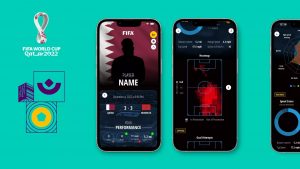 When the FIFA World Cup began just a few weeks ago, most participating players received a unique QR code that gave them access to the FIFA Player App, a bespoke analytics tool that improves players’ access to and use of match data.
When the FIFA World Cup began just a few weeks ago, most participating players received a unique QR code that gave them access to the FIFA Player App, a bespoke analytics tool that improves players’ access to and use of match data.
FIFA’s Football Technology & Innovation division developed the FIFA Player App, based on input from professional players, in collaboration with FIFPRO, the global representative of professional footballers and is being used for the first time at a FIFA World Cup™ in Qatar.
The FIFA Player App provides the opportunity for each player to access their individual performance data, linked to videos of relevant match action, minutes after each match.
The app has proved very popular, with over 400 players registering for the service, including Croatian star Luka Modric.
“It helps you realize what mistakes you might have made during the game,” Modric told FIFA.
“Sometimes similar things or scenarios will happen to you on the pitch in two separate games, so by using this app I can see what I did in that particular moment which was not good and try to correct it for the next game. That is why from the early start of my career, I always like to review the game highlights and see what we could have done better.”
Switzerland’s Xherdan Shaqiri agrees.
“To see how your performance was, you have pictures in there as well, so it was a very good idea by FIFA to introduce it,” said Shaqiri.
“I really like it and it’s just something new that didn’t exist before.”
The FIFA Player App ‘s outputs are based on the FIFA Football Language, developed under the supervision of FIFA Chief of Global Football Development Arsène Wenger, to be the blueprint for how we analyse football in the future.
“They (players) get analysis of their performances through our Football Language and will get used to the way we analyse the game. So, it will be a common language that exists,” said Wenger.
“The players are very intelligent and, usually, they adapt quickly. We will make the quality of their performances available, and that’s what the Football Language is for.”
The data collected includes enhanced football data metrics, such as whether a player made an offer or movement to receive the ball, physical performance metrics, collected through a highly accurate in-stadium tracking system, and enhanced football intelligence metrics, created by the FIFA Football Performance Analysis & Insights team.
“This data is then combined and synched with video to enable us to send all the key moments of their game play to the player directly after the game,” explained FIFA Football Data Scientist Bahaeddine El Fakir.
“I believe we have over 400 players that are consistently using the app right after the match, which is, of course, very exciting. This also sets a new standard for football data distribution in the future.”
This innovation is a first visible outcome of the collaboration between FIFA and FIFPRO on the development of standards and best practices for the collection, protection and use of personal player-performance data.
“The Player App can really benefit the game and the experience of the players as they will understand those critical moments and aspects of the match. Most importantly, the players can access their highlights and protecting their data through the Charter of Player Rights, which is a critical part of this project. I think this really is an important piece for the future management of player performance data. It is one of those areas where we’ve jointly agreed with FIFA that collaboration and co-creation is an important part to strengthen the game, “explained Simon Colosimo, Deputy General Secretary of FIFPro
FIFA will utilise the Player App again for the 2023 FIFA Women’s World Cup next year in Australia and New Zealand.
 Arunava about Football A look at football & the world through my eyes!
Arunava about Football A look at football & the world through my eyes!



